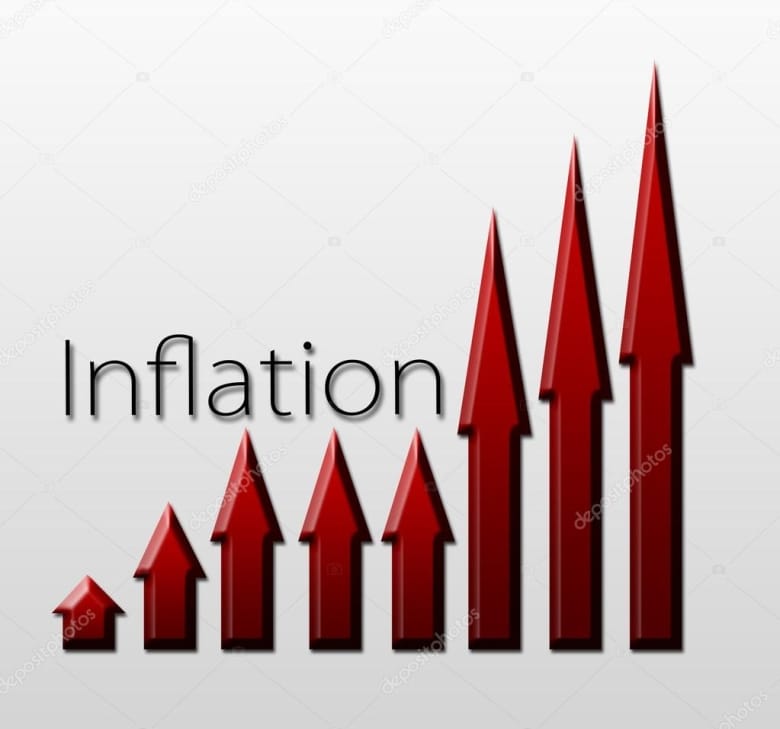
Inflation.
Inflation, in economics, is the generalized and sustained increase in the prices of goods and services existing in the market during a certain period of time. When the general price level rises, each unit of currency buys fewer goods and services. In other words, inflation reflects the decrease in the purchasing power of the currency: a loss of the real value of the internal means of exchange and unit of measurement of an economy. A frequent measure of inflation is the price index, which corresponds to the percentage per year of the general variation of prices in the.
The effects of inflation on an economy are diverse, and can be both positive and negative. The negative effects of inflation include the decline in the real value of the currency over time, the discouragement of saving and investment due to uncertainty about the future value of money, and the scarcity of goods. The positive effects include the possibility for the central banks of the states to adjust nominal interest rates in order to mitigate a recession and to encourage investment in non-monetary capital projects.
How ordinary citizens feel it is of a different nature, to explain exactly what inflation is, beyond academic definitions and technical criteria, it can be explained simply with an illustrative example, last week you went to the hypermarket and filled the car for a hundred euros, inflation rises and this week those same hundred euros only fill half the car.
The CPI rises in February in Spain
The annual variation rate of the CPI in Spain in February 2022 was 7.4%, 1.3 points higher than that of the previous month. The monthly variation of the CPI (Consumer Price Index) has been 0.6%, so that the accumulated inflation in 2022 is 0.2%.
The CPI, (Consumer Price Index) or inflation in Spain measures the evolution of the set of prices of goods and services consumed by the population residing in family homes in Spain. The CPI, also called the General CPI, is made up of the following groups of goods and services: - CPI for food and non-alcoholic beverages - CPI for alcoholic beverages and tobacco - CPI for clothing items - CPI for housing rentals - CPI for household items - CPI for medicines - Transport CPI - Communications CPI - Leisure and Culture CPI - Education CPI - Hotels, cafes and restaurants CPI - Other goods and services CPI Each of them is prepared at three levels: - Provincial CPI - Autonomous CPI - National CPI what allows us to know how much the products belonging to any of the above groups have become more expensive in a given period, both in Spain and in any of its Autonomous Communities and in its provinces. The National Institute of Statistics (INE) establishes, through family budget surveys, which products and in what proportion make up the "shopping basket".
In this way, the rise in prices is the index that marks the rise in inflation, with the consequent loss of purchasing power of salaries and pensions that do not rise at the same level.
This generates a tension in the social agreements, since the unions try to pressure the companies to raise wages in the same proportion as inflation, without understanding that this is a dangerous dynamic that will surely only ruin the companies that will not be able to to face, on the one hand, the increase in the cost of raw materials and energy, unleashed by inflation.
Nor, on the other hand, to the increase in wages, demanded by the unions, which will result in the closure of many companies as they cannot face the rise in production costs alone, already high due to inflation, but also due to the rise in required wages, the worst possible scenario of this absurd race of rises, both those of the CPI and the one required to compensate it by the unions, will be stagflation.
Stagflation indicates the moment or economic situation in which, within an inflationary situation, there is a stagnation of the economy and the rate of inflation does not yield.
Stagflation combines the terms "recession" (or stagnation) and "inflation"; it is the economic situation that indicates the simultaneity of rising prices, rising unemployment and economic stagnation, entering a crisis or even recession.
Formally, a recession is determined when the Gross Domestic Product (GDP) decreases for two consecutive quarters. When the recession is accompanied by high inflation, the process is called stagflation; it is considered one of the worst possible economic scenarios due to the difficulty of handling and correcting it.
The monetary and fiscal policies that are usually used to revitalize a recessive economy worsen the inflationary component of stagflation, and the restrictive monetary policies that are used to combat inflation tend to deepen and widen its recessive component.
Stagflation completely distorts markets and puts government policy makers and their central banks in a 'lose-lose' position.
In stagflation, the recession is usually partial, simultaneously registering the decrease of some sectors, such as the production of goods, together with the growth of other sectors, such as the production of services.
If it is a relatively open economy and inflation is accompanied by a devaluation process, there may be a contraction of activities that consume foreign currency and an expansion of those that generate foreign currency.
This represents an enormous challenge for the authorities as they receive mixed and contradictory signals about the economy that make it very difficult to decide which policies to apply, in what sequence and when to take them. "It's the worst of both worlds" say many economists.
That said, we want our leaders to know how to face the situation with courage and decisive policies, instead of doing, as almost always, hiding reality until it causes the crisis and recession.